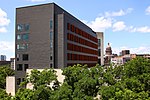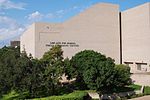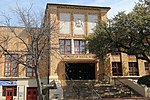Frank Erwin Center

The Frank C. Erwin Jr. Center (commonly known as Frank Erwin Center or UT Erwin Center and originally Special Events Center) is a multi-purpose arena located on the campus of the University of Texas at Austin in Austin, Texas. It is also sometimes referred to as "The Drum" or "The Superdrum", owing to its round, drum-like appearance from outside (not to be confused with Big Bertha, the large bass drum used by the University of Texas marching band). The multi-purpose facility hosted entertainment events and was the home court for the Texas Longhorns men's and women's basketball programs until 2022, when it was replaced by the Moody Center. The Erwin Center is located at the southeastern corner of the UT central campus and is bounded on the east by Interstate 35.
Excerpt from the Wikipedia article Frank Erwin Center (License: CC BY-SA 3.0, Authors, Images).Frank Erwin Center
Red River Street, Austin
Geographical coordinates (GPS) Address External links Nearby Places Show on map
Geographical coordinates (GPS)
| Latitude | Longitude |
|---|---|
| N 30.277 ° | E -97.7322 ° |
Address
Frank C. Erwin, Jr. Special Events Center
Red River Street 1701
78701 Austin
Texas, United States
Open on Google Maps











